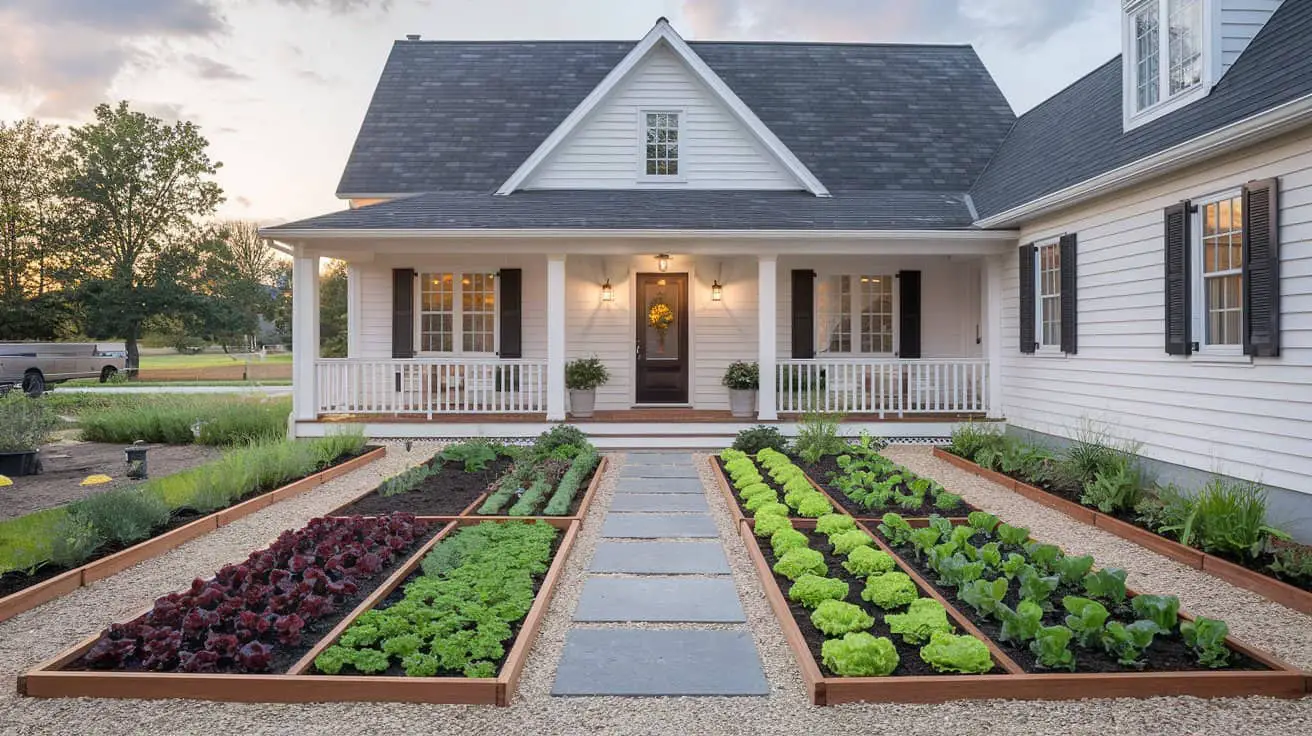
So… you’ve been daydreaming about a ranch, right? Not the dressing—although fair—but the kind with chickens clucking somewhere out back, a barn with actual charm, and maybe a veggie garden that doesn’t instantly give up on you after one rainstorm. You’re not alone. There’s something about the idea of a family homestead that feels really right these days. Whether you’ve got a full three-acre layout in the works or you’re just flirting with the idea of a backyard chicken coop and some raised beds, the dream’s alive and clicking.
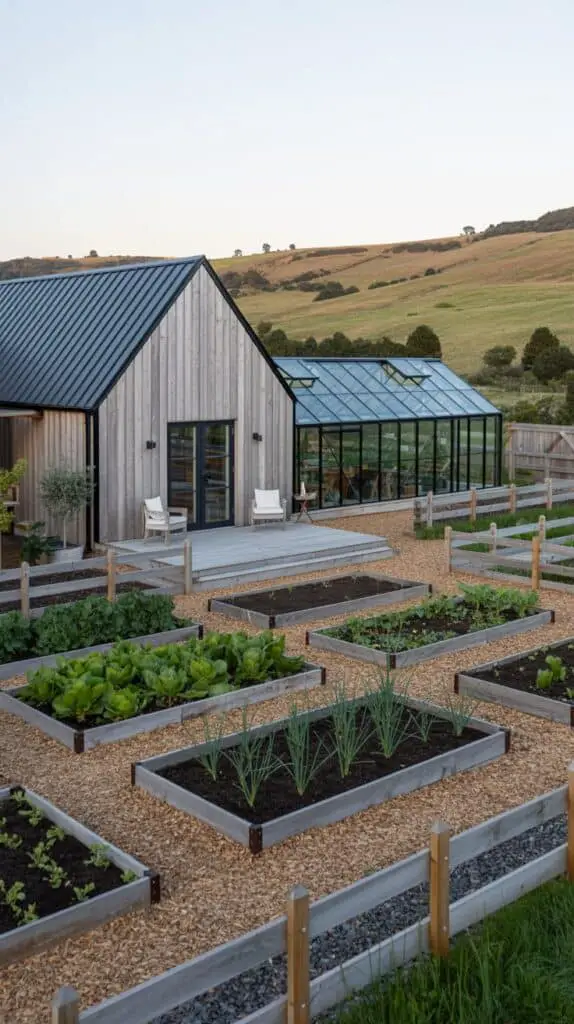
We’re not talking about ultra-polished, off-grid influencer farms here (although—respect). This is about that sweet middle zone: real, livable, lovely ranch-style homesteads where families grow stuff, raise animals, and maybe argue over which tomato plant is “actually doing best.”
And you don’t need to move to Montana or marry a cowboy to make it happen. Some of these homestead designs work in suburban lots. Some are perfect for gently rolling fields. All of them? Rooted in family life, a love of the land, and a little bit of sweat.

Let’s walk through 10+ ranch-friendly homestead layouts and ideas that blend practicality with Pinterest-worthy style. Starting with…
Backyard Ranch Design with a Side Garden Barn
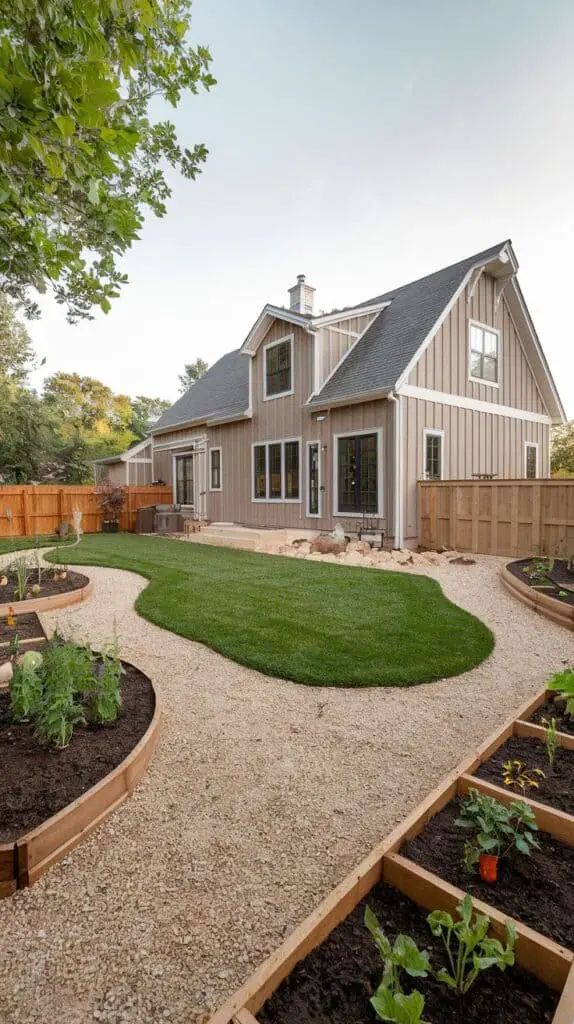
This one’s for families who want that ranch vibe without going full “Little House on the Prairie.” Think of a home with an L-shaped backyard that carves out room for both play and purpose. The central open space is great for kids and dogs to run wild (and they will). But off to one side? A simple wooden barn painted in soft earth tones. Not massive. Just enough to house tools, seed trays, maybe even a couple of goats.
The barn also doubles as visual structure—it gives your outdoor space a reason to flow. You can build a gravel path curving from your back door to the barn, with garden beds lining the way. Some families plant organic tomatoes here. Others try vertical herb gardens along the fence. Whatever you grow, it instantly makes your backyard feel like more than a patch of grass—it becomes your little slice of working land.
To soften the edges, try adding terracotta pots with lavender and rosemary, and maybe hang a wind chime from the barn’s edge. It feels rustic but intentional. Very “small farm life” without needing five acres.
Can a Three-Acre Layout Still Feel Cozy? Absolutely
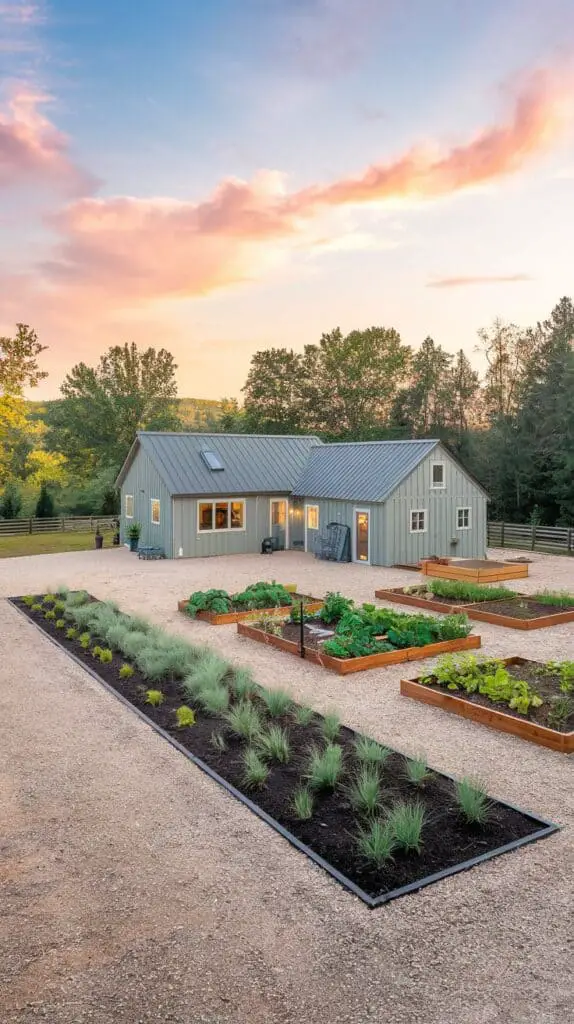
Sometimes a bit of land can feel… too open. Like you’ve got space but don’t know how to use it. This layout solves that by dividing your three-acre plot into “zones” with meaning. Picture a long gravel driveway lined with native grasses. The house sits central—but not dominating—framed by low, natural stone garden beds.
Behind the house? That’s where the real action happens. A fenced-in organic garden takes up a generous corner. You’ve got a mix of ground plots (carrots, beans, garlic) and raised beds (lettuces, herbs). Nearby, a modest chicken run with a modern coop design—wood, metal roofing, maybe a soft green paint—keeps the flock happy and adds life to the land.
There’s a firepit circle near the edge of your property, set between fruit trees. In the evenings, the whole space becomes golden. This kind of layout makes even a larger property feel intimate, with each section tied to a rhythm of daily family life.
The Homestead Courtyard with Functional Flair
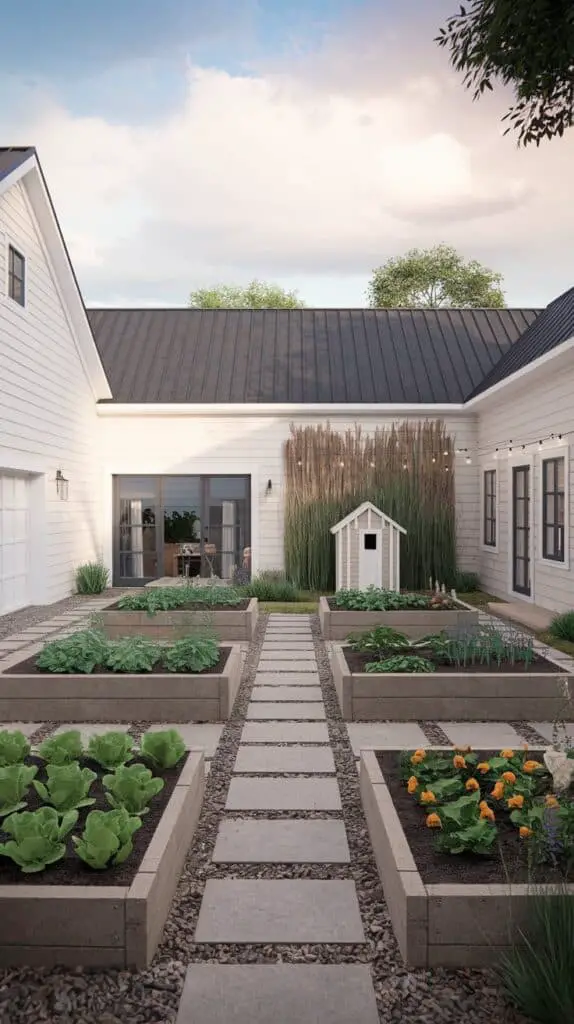
If you’ve got an eye for layout and love the idea of everything connecting inward, a courtyard homestead might be your thing. The home wraps around a central outdoor space, with wings that open into a shared courtyard used for both growing and gathering.
In the courtyard? Raised stone garden beds planted with lettuces, radishes, and flowers that attract pollinators. Maybe a rustic pergola draped in vines or solar fairy lights. You can tuck a chicken coop against the garage wall, softened by tall grasses or a small bamboo screen.
The idea here is simplicity: everything you need is close. You don’t have to walk half a mile to grab an egg or snip some parsley. And because it’s all visually enclosed, it creates a natural sense of peace and privacy.
This layout suits both rural plots and modern farmhouses in suburban zones. It also works great if you’ve got younger kids—you can watch them play while you water the mint and worry about literally nothing else for five whole minutes.
Barn Garden Ideas for a Sloped Property
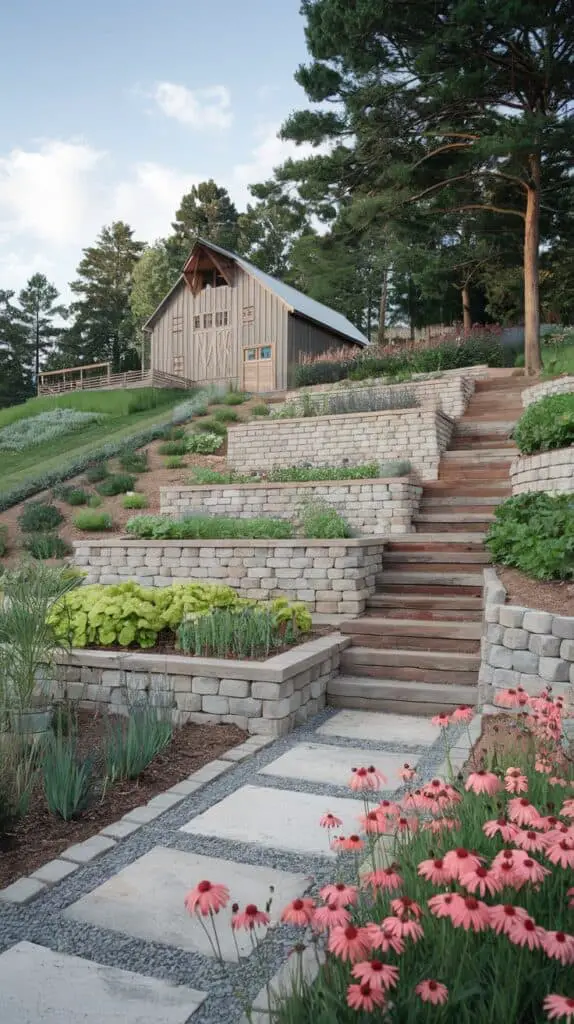
Got uneven ground or a slope to your land? Use it. Instead of trying to flatten everything, design your barn and garden layout with the incline. A timber-framed barn sits at the top, catching the best morning sun. Below it, you stagger your garden beds down the hill—stone retaining walls double as terraces and protect your soil from washing out.
Each level can be themed. One for leafy greens and herbs. Another for hardy root veg. And maybe one with a sandbox or play area if you’ve got kids. It’s like a farm-garden-staircase, but prettier.
Access paths can be made from decomposed granite or weathered brick. If you’ve got the budget, you could even line them with native flowers like coneflowers or yarrow for that soft, lived-in charm.
The barn at the top becomes both the focal point and a windbreak. It stores tools, shelter for animals, and even firewood. And at sunset? The views are unmatched. Who knew sloped land could be the best feature of your whole property?
Organic Garden with a Hidden Chicken Yard

This one leans into the secret-garden vibe. Start with an organic veggie patch that’s honestly just a bit overgrown—in the best way. Think heirloom tomatoes climbing trellises, rows of bushy basil, nasturtiums spilling over the edges of raised cedar beds. Wind a stepping-stone path through the beds toward a low wooden gate…
…and behind it? A small but perfectly functional chicken yard. It’s tucked behind a flowering hedge or a line of tall sunflowers, out of sight but full of life. The coop is painted white with a tin roof, and maybe there’s even a grapevine creeping up one side.
This design feels magical. It’s ideal for smaller properties or corner plots. The garden gets all the spotlight, and the animals stay cozy and protected in their nook. Plus, it’s fun. Kids love sneaking back there to collect eggs or feed scraps. You feel like you’ve got this secret, living world just steps from the back door.
Sideyard Garden Rows with a Tool Shed Ranch Setup
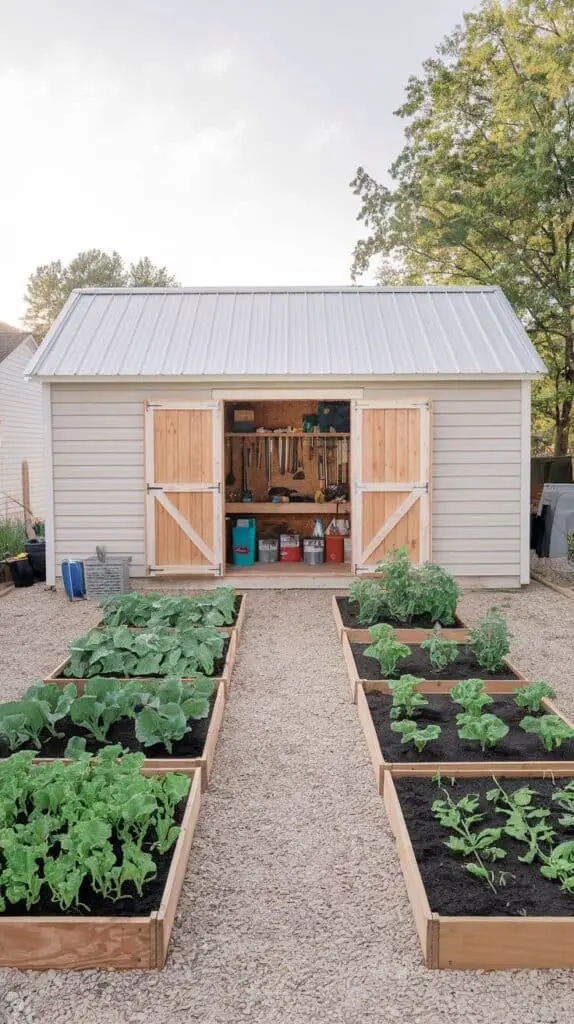
Let’s talk about the side of the house. You know, that weirdly narrow strip that usually just collects forgotten soccer balls and old rakes? Yeah, that can be prime homestead space.
This design takes advantage of the sideyard by laying out tidy garden rows running alongside the house. Start with a crushed gravel path, then add three to five neat rows of ground garden beds filled with seasonal crops—cabbage, carrots, peas. You can build the beds right into the earth, or use low wooden borders to help hold shape and moisture.
At the far end of the strip? A small ranch-style tool shed. Nothing fancy—just wide double doors, warm natural wood, and maybe a metal roof to match your house. This shed becomes the heart of your growing setup. Inside, hang tools, store seed packets, and keep those big bags of compost out of the rain.
If you add a few trellises against the wall—beans, cucumbers, or even climbing roses—the whole side of the house transforms from forgotten zone to a working mini-farm that feels like it was always meant to be there.
Split-Zone Backyard with Goats and Greenery
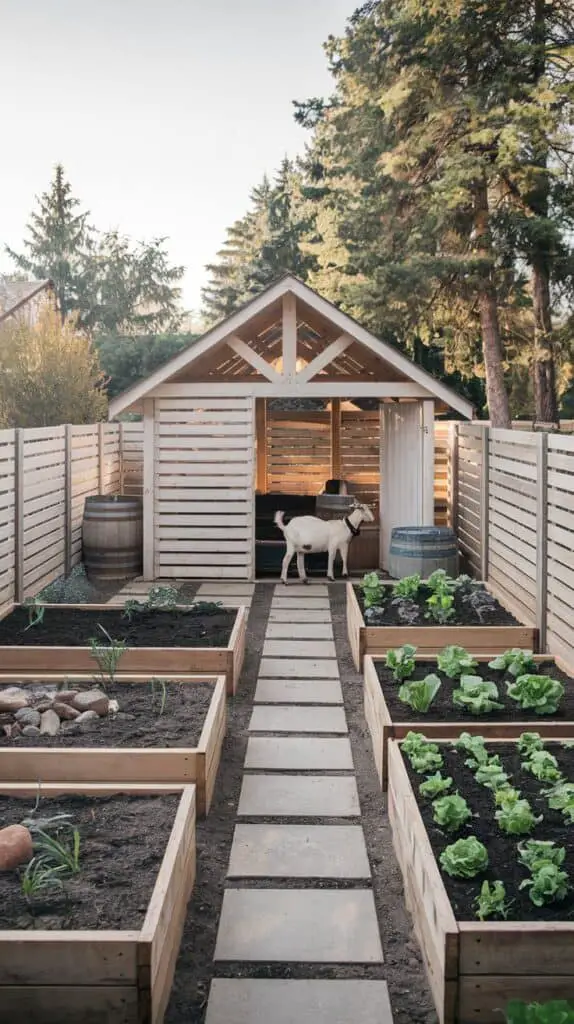
If your family’s ready for something a little more adventurous (read: goats), try a split-zone backyard design. Divide your space into two clear areas: one for your veggie and herb garden, and the other for small livestock.
Start with fencing. Use horizontal wood slats or rustic wire fencing to give each section its own personality. The garden area can be neat and tidy—raised beds in geometric patterns, a paver path running through the middle, maybe a couple of old wine barrels for bonus planting. Think functional but charming.
On the other side, build a small goat shelter that’s visually appealing—wood beams, sloped roof, and enough ventilation. Add a rock pile for enrichment and space for shade. Goats are great for clearing weeds, and honestly, they’re hilarious. Just maybe don’t plant your prized tomatoes too close.
This layout works best for slightly larger yards but doesn’t need acreage. It creates that “working homestead” feel while still keeping your spaces clean, organized, and photo-worthy.
Modern Farmhouse Ranch with Gravel Paths and Edible Borders

Want a setup that feels chic and practical? Go with a modern farmhouse layout using a strong backbone of gravel paths and edible landscaping. This design suits both newer homes and remodeled ranch houses, especially on flatter land.
Start with a T-shaped layout: your house at the top of the T, and the long part leading straight through the backyard. On either side of the central gravel path, design your garden beds in low geometric shapes. Use materials like painted brick or poured concrete for clean lines, but fill them with lush, edible plants—purple kale, red romaine, and maybe even nasturtiums to break up the formality.
Border the paths with dwarf fruit trees or blueberry bushes in mulch rings. Add solar lights to guide the way in the evenings, and tuck a minimalist bench here and there so you’ve got spots to pause with coffee or a hose.
The ranch vibe comes through in the color palette (think soft green, natural wood, and whitewashed accents), while the function is all about small farm life. Everything looks intentional but feels relaxed.
Backfield Dream Homestead with a Winding Orchard
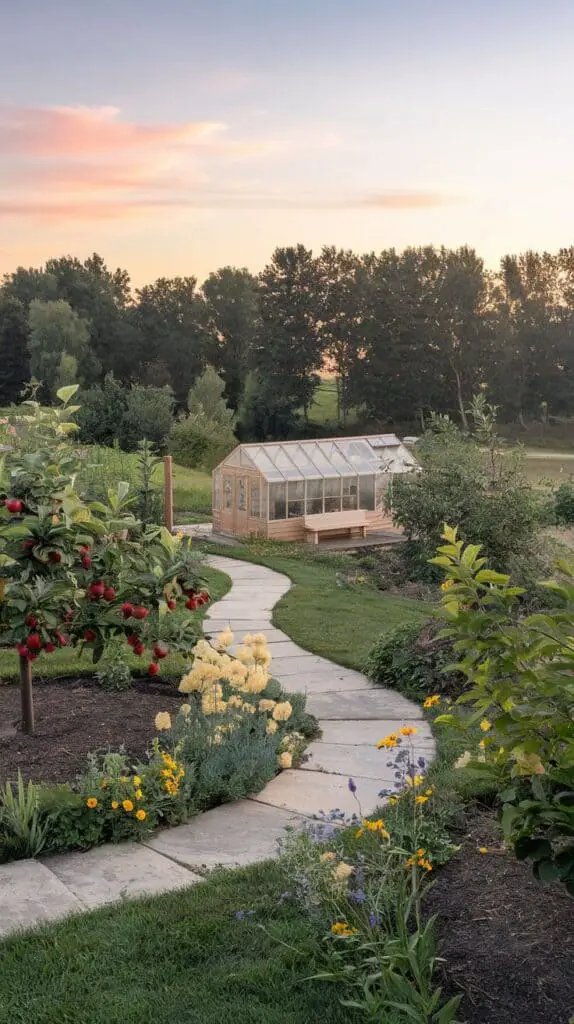
For those lucky enough to have a bit more land out back, this layout leans into the dream homestead fantasy—without going overboard. The house sits front and center, but the magic is what happens behind it.
Instead of one big open space, carve out a winding orchard path. Plant trees like apple, fig, peach, or persimmon, depending on your climate. Space them just far enough apart to feel like an orchard, but close enough that it feels cozy and immersive as you walk through. Underplant with wildflowers, ground clover, or low herbs like thyme to avoid mowing nightmares.
Nestled halfway down the orchard trail? A cedar greenhouse or poly hoop house for extending your growing season. Build a small bench outside it. Maybe a rain barrel setup on one end. At the very back, a wild garden bed that leans into permaculture—whatever’s in season, popping up between native shrubs and self-seeding herbs.
This kind of homestead makes your land feel like a story you walk through. Every turn brings something new: a plum tree in bloom, bees busy in the lavender, a surprise batch of strawberries underfoot.
Ranch Front Yard Conversion with a Formal Garden Twist

Most people forget: the front yard is usable land. So if you’ve been mowing the same rectangle for years, maybe it’s time to rethink it as part of your homestead.
This design transforms your front space into a structured ranch-style garden with a formal edge. Keep a walkway to your door, but frame it with symmetrical planting beds. Instead of boxwoods and roses, plant rows of Swiss chard, colorful lettuces, or fennel. Use gravel or brick edging to keep things tidy and add visual order.
On one side of the porch, build a decorative wooden trellis and grow runner beans or sugar snap peas. On the other, a low-growing herb spiral adds both beauty and usefulness. If local rules allow, add a few potted citrus trees or a dwarf fig on either side of your entryway for symmetry.
By day, it’s a functioning edible garden. By evening, it’s a quiet, earthy welcome home. And yes—your neighbors might raise their eyebrows at first. But soon they’ll be asking for your kale.
Final Thoughts
A ranch-style homestead doesn’t have to mean giant tractors, 100 chickens, or quitting your job to milk goats at sunrise. It’s more about the rhythm of the space. A place where you grow food, share chores, build memories, and maybe even name your wheelbarrow because, honestly, it’s earned it.
Whether you’re working with a full three-acre plot or a modest backyard, these homestead designs are here to remind you that small farm life is more of a feeling than a measurement. It’s in the way your kids snack on cherry tomatoes straight from the vine, the smell of herbs drifting in from the porch, or the sound of rain on a tin-roof chicken coop.
So go ahead—choose one (or three) of these ideas and get started. You might be surprised how much life, joy, and good dirt under the fingernails it brings.
